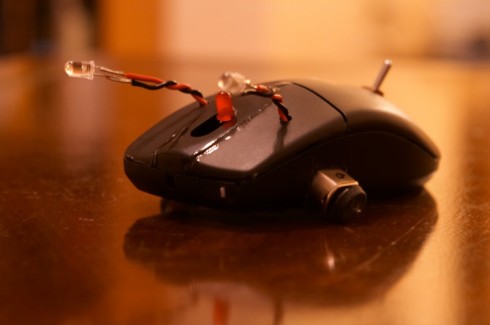Feivel
Feivel was my very first robot. He's a little phototropic (light-seeking) robot built into an old computer mouse case. I'm nowhere near clever enough to come up with the simple circuit that controls him -- it's the classic 'Herbie' circuit by Randy Sargent, using an LM386 op-amp (originally intended for use as an audio amplifier) to read the difference in light level between the two infrared phototransistor 'eyes' and use that to split the voltage between the two motors. When both eyes are seeing the same amount of light, the 9V gets split evenly into 4.5V for each motor. When one eye sees more light than another, the op-amp directs more voltage to the motor on the opposite side, which makes the robot turn towards the light. The end result is that Feivel seeks out the brightest light in the room. It also has the added side-effect (as you can see in the video) that when he finds himself on a shadow with bright floor on either side, he'll tend to follow along the shadow, since neither eye wants to move into the shadow. Emergent behavior!
One surprising fact I learned while working on this robot is that, just like a motor will also function as a generator (and vice versa), and a speaker will function as a microphone (and vice versa), LED's also function as light sensors. Any plain old LED will produce a slight voltage across its pins when exposed to light. The 'eyes' on Feivel are actually the infrared emitters that used to be inside the mouse to determine the position of the ball -- it turns out that the emitters work better than the receivers as general light sensors. Crazy.
Since this was my first robot, I took a bunch of pictures of the entire construction process. Since I have no code or programming logic to share for this one, I'll just post some of those :)
Seek the brightest light in the room
- Actuators / output devices: Two small 9V motors
- CPU: LM386 op-amp
- Power source: 9v battery
- Sensors / input devices: I/R phototransistors
- Target environment: indoor


